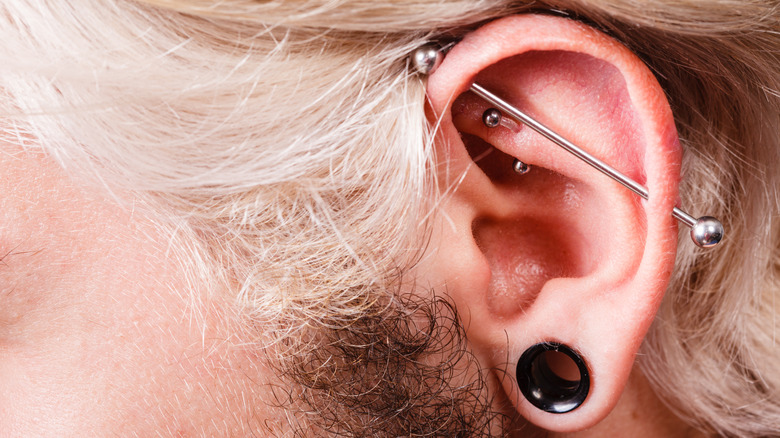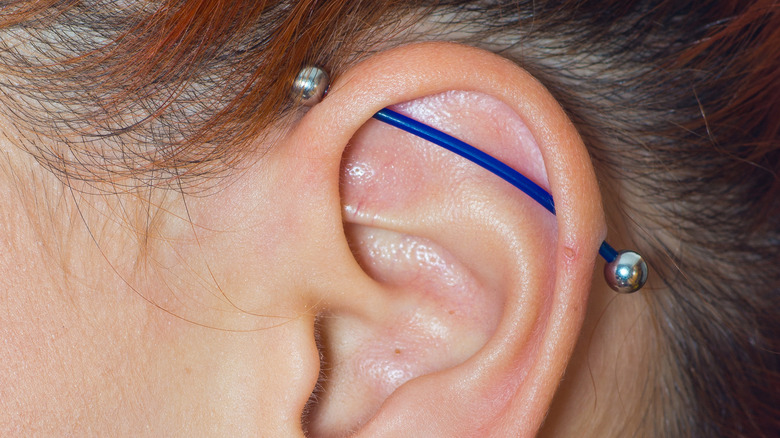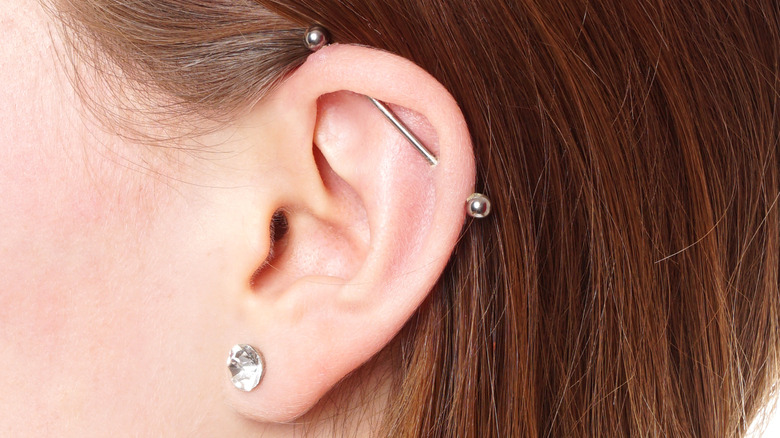The Truth About Bar Piercings
Bar piercings, often referred to as industrial or scaffolding piercings, are nothing to take lightly. This is because they pass through two different points in the body: the outer helix and the forward helix. This opposes most ear piercings, so you need to make sure you get a professional piercer with lots of experience to perform this procedure.
The first versions of the bar piercing were spotted in the early '90s, and were invented by piercer Erik Dakota, per Oufer Body Jewelry. Used with a 14 to 18 gauge straight barbell made of either implant grade stainless steel, titanium, or gold, they give a fierce, edgy look. If you're sure you want one, keep in mind that it is a big commitment, and you need to make sure that you're prepared. Read on to learn all the things you need to know if you plan on getting a bar piercing.
The process used for a bar piercing is quick, but may be painful
The first thing to note when you visit your local tattoo parlor or piercing shop for a bar piercing is if you're actually an eligible candidate. Some people can't get a bar piercing due to their anatomy, as some people don't have a prominent enough ridge at the top of the ear, as noted by Urban Body Jewelry. If you're good to go, be sure to prepare yourself for a moderate amount of pain. The bar piercing can definitely be on the more uncomfortable side, because you're being pierced twice with a fairly thick needle in a very short amount of time.
"There are several methods, but I would say typically a piercer would first pierce one side with a single-use disposable needle then insert jewelry into it that is long enough to support both piercings," Atlanta-based piercer Cozmo Faris told Byrdie. "A second needle would then be used to make the other piercing, and the excess room on the jewelry would then be transferred into the second piercing connecting them." If you think you can handle that process, you should totally go for it because the process only lasts a few seconds.
The truth about healing the bar piercing
Given the fact that you're being pierced through cartilage twice, the healing time is no joke. The average time to heal following a bar piercing is anytime between four months and six months, per Byrdie. And if you don't take care of things properly, side effects such as infection, rejection, and unsightly keloids can occur. "Connecting two piercings with a single piece of jewelry isn't the easiest thing for your body to adjust to so it is pretty important to be diligent with aftercare," said professional piercer Cozmo Faris. The piercing must be cleaned with saline twice daily, and you cannot sleep on the pierced side of your face during this process.
Although this may sound overwhelming, the bar piercing can be totally worth it. Perhaps the best part about the bar piercing are the many versatile and customizable options you can choose from, including curved, spiraled, or straight barbells with or without gemstones or decorations. "Separating the two costs allows the client to leave with something as simple as a basic titanium barbell or as nice as a solid gold barbell with genuine diamonds. We have dozens of jewelry options," Faris explained.
So if you're going to give your ear that bling-but-rebellious look, be sure to remember what you learned about the bar piercing!


